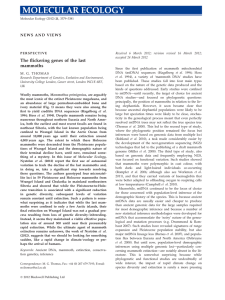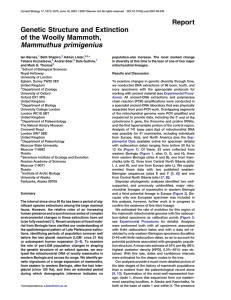Denver Museum of Nature & Science
advertisement
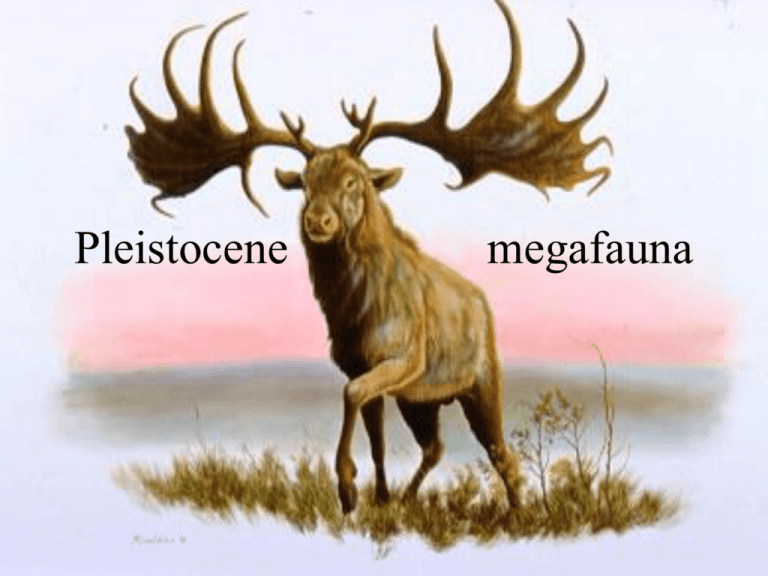
Pleistocene megafauna Reference sites Yukon Beringia Interpretive Centre http://www.beringia.com/01/01maina1.html University of Texas at Austin: http://cluster4.biosci.utexas.edu/deathvalley/Art/paleoart.htm Denver Museum of Natural Science http://www.dmns.org/iceage/ia_giants/index.html Kokogiac Media http://www.kokogiak.com/megafauna/resources.asp Rancho La Brea Asphalt Deposits Millions of years ago, the area of Los Angeles and Rancho La Brea lay beneath the surface of the Pacific Ocean. During this time, marine sedimentary layers formed and in some places these eventually became rich with fossil fuels produced from ancient sea life. When the ocean levels receded some 100,000 years ago, the area of Rancho La Brea became land. New layers of gravel, sand, and clay formed by the erosion of the emergent hills, and settled on top of the much older marine sediments full of oil. At Rancho La Brea, the crude oil has been seeping out of the ground through conduits and fissures in the coastal plain sediments for the past 40,000 years, the seeps forming pools in lowlying areas. Bison antiquus graze with Western quaggas (Equus occidentalis) on a grassy flat in what is today San Francisco Bay ca. 40,000 years BP.. Made famous by the La Brea Tar Pits in Los Angeles, these extinct mammals roamed over wide areas of the West during the Pleistocene epoch, which ended about 10,000 years ago. Western Quaggas (Equus occidentalis), related to today's zebras apparently, graze with Bison (Bison antiquus). Harlan’s Ground Sloth Harlan's ground sloth was related to modern tree sloths, but were much larger, standing about 6 feet (1.8 meters) tall and weighing 3,500 pounds (1,600 kilograms). It had very large, powerfullybuilt limbs and claws. Harlan’s ground sloth moved in an unusual manner, walking on the backs of its forefeet and the sides of its hind feet. A scene in the low deserts of Imperial County, California of about 11,000 years ago, showing a Shasta ground sloth (Nothrotheriops shastense), an animal perhaps resembling something in between an anteater and a tree sloth. Plants include Agaves (Agave deserti), Calico cactus (Echinocactus engelmanni), and Brittlebush (Encelia farinosa). This small ground sloth was distributed over California, Nevada, Arizona, New Mexico, west Texas, southern Utah, northern Mexico, and southern Alberta. Western Camel (Camelops hesternus) North American had native camels 10,000 years ago. Today camels are native to Asia and Africa. The extinct form probably looked like a large dromedary, with longer limbs, toes not as flattened, and perhaps a mid- dorsal hump. Large-headed Llama (Hemiauchenia macrocephala) Dire wolf (Canis dirus) A pack of Dire wolves attacks a Western quagga (Equus occidentalis). This wolf had slightly shorter legs and a broader snout and heavier jaws than the modern Gray wolf (C. lupus). It may have been adapted to dealing with the larger prey fauna of the Pleistocene. The hyena niche may have been occupied by this species, as a hunterscavenger on large animals. In particular, it may have taken advantage of feeding on the remains of Saber-tooth cat kills, as that predator could not ingest large bones with its long canine teeth. This large wolf has been made famous by depictions of the La Brea tar pits, where hordes of Dire wolves scavenge dying animals trapped in the tar. University of Texas, Austin Saber-toothed Cat (Smilodon fatalis) As its name indicates, the saber-toothed cat had large canines that were up to 7 inches (18 centimeters) long. Saber-toothed cats were about the size of modern African lions, and had short, powerful legs, indicating that they probably hunted by ambushing their prey rather than chasing them down. Remains of saber-toothed cats have been found throughout North and South America. Denver Museum of Nature & Science A pencil sketch showing two Saber-tooths stalking a herd of Western quaggas (Equus occidentalis) in a freshwater marsh with Tules (Scirpus sp.) in California's San Joaquin Valley. A Llama (Hemiauchenia macrocephala) walks beyond the herd, and an Asphalt stork (Ciconia maltha) is in the distance. In the water are White pelicans, Shovelers, Ruddy duck, American avocets, and Western grebes. A Golden eagle soars overhead. A desert tortoise (Gopherus agassizii) wanders off into the Saltbush flats (Atriplex polycarpa). Short-Faced Bear The short-faced bear was the largest carnivore in North America during the Ice Age. It was taller than the brown (grizzly) bear, with longer, more slender hind legs, and a relatively short face that was more reminiscent of a lion rather than any living North American bear. In North America, the short-faced bear occupied the high grasslands west of the Mississippi, from Alaska to Mexico. In these areas, it probably preyed upon bison, deer, and horses. A herd of Columbian mammoths in a coastal California Redwood belt. These elephant-like beasts were 10 to 11 feet tall at the shoulder. Bulls had massive sweeping tusks, possibly used to shovel and scrape away brush or debris in feeding. Wear facets are deep and smooth the ivory, but are difficult to interpret, as the tusks grow in a spiral manner. Males also may have fought using the tusks-- in Nebraska, two fossil mammoth skulls were found locked together. COLUMBIAN MAMMOTH The Columbian Mammoth (Mammuthus columbi) was the largest mammal to have been trapped in the La Brea Tar Pits. Some individuals stood over 13 feet tall. The mammoth migrated into North America from Asia about 2 million years ago. The Columbian Mammoth was larger, but less hairy, than the wooly mammoth which lived near the ice sheets in the northern end of the continent. The mammoth became extinct about 11,000 years ago - about the same time the first humans migrated into North America. The tusks of the Columbian mammoth were up to 14 feet (4.25 meters) long, and its washboard-like teeth were well-suited for chewing grass. TIME - Late Pliocene to Late Pleistocene RANGE - North America, south of the ice sheets. DIET - Mostly grass but also leaves. SIZE - 12ft (3.6 m) at the shoulders. WEIGHT - 10,000 lbs (4,600 kg) University of Texas, Austin American Mastodon Mastodons were distant relatives of mammoths and elephants. In North America, they were generally smaller than mammoths, standing about 7-8 feet tall at the shoulder. Unlike the washboard-like teeth of mammoths, mastodons had blunt, cone-shaped teeth that were probably used to chew leaves and pine needles in wooded areas. Teratorns (Teratornis spp.) Teratorns were related to condors, but were much larger usually. Three species were found as fossil in the western United States, and the above form, Merriam's teratorn (Teratornis merriami) was distributed in California, southern Nevada, Arizona, and Florida. It had an incredible wingspan of 11 to 14 feet. The extant California condor (Gymnogyps californianus) has a wingspan of 9 feet. These giant vultures as a group went extinct at the end of the Pleistocene, possibly from the reduction in large carcasses due to megafaunal extinctions. University of Texas, Austin. North of the ice sheet WOOLY MAMMOTH mammuthus primigenius This well known mammoth was a cold climate dweller equipped with a thick layer of fat for insulation, and an exterior of long black hair. It was smaller than most mammoths, and had a hump of fat behind its domed head. It fed on low tundra vegetation in which it scraped away snow and ice from with its ivory tusks. Several well preserved remains have been found in Siberia and Alaska and cave paintings in Spain and France show depictions of the Wooly Mammoth as seen by early humans. The mammuthus primigenius went extinct only about 10,000 years ago. TIME - Late Pleistocene RANGE - Europe / North America / Asia DIET - Tundra vegetation SIZE - 9ft. (2.7m) high University of Texas, Austin WOOLY MAMMOTH mammuthus primigenius Columbian Mammoth mammuthus columbi Enter man . . . Mellars, NATURE, 432, 462-465 Late Pleistocene Modern • and Neantherthal • sites in France Homo Floresiensis Morwood, NATURE, 431, 1087 Caverne Chauvet, France Butchering site Lange, S. Dakota



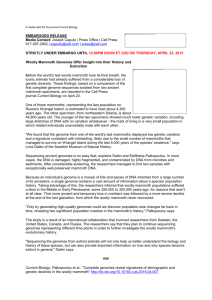
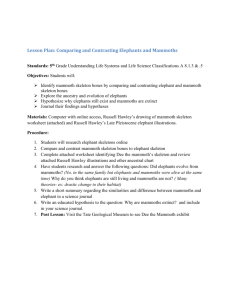

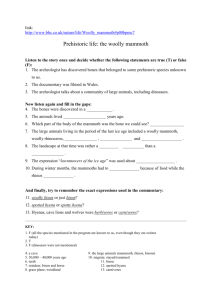
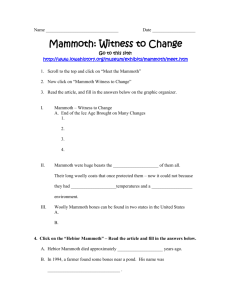

![[date] Mr. Theodore Schade Mr. Steven L. Nelson Air Pollution](http://s3.studylib.net/store/data/007013598_1-3d330ddff330ed2bd0a1f2fb95eff24b-300x300.png)
